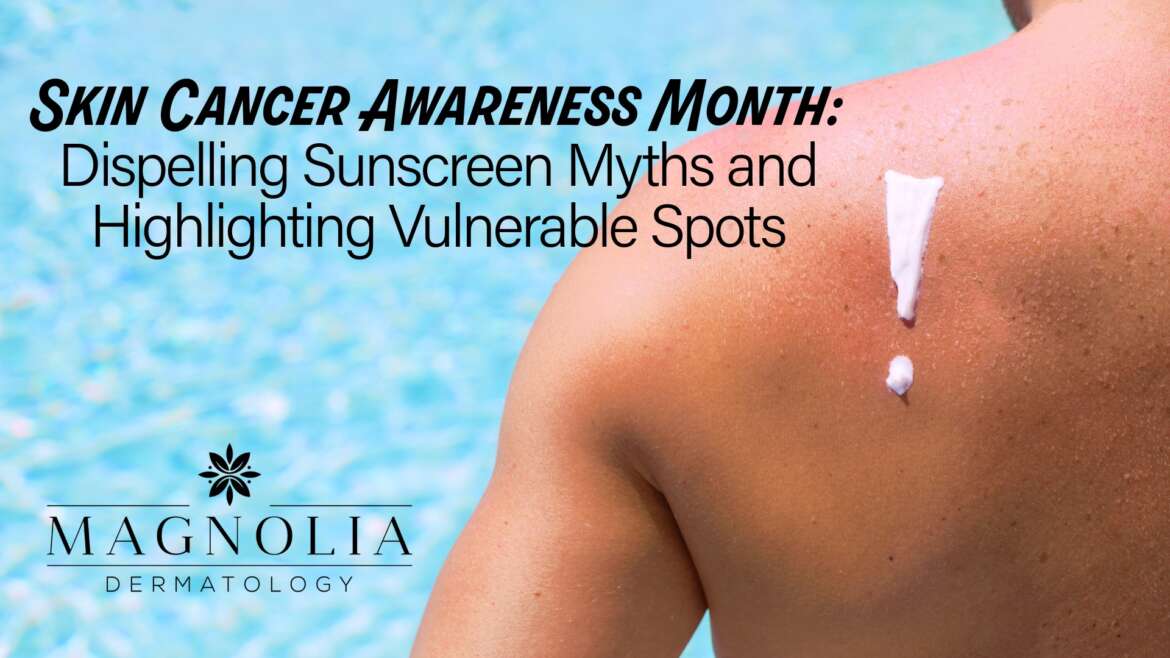May is Skin Cancer Awareness Month, and at Magnolia Dermatology, we’re dedicated to educating and empowering our community to protect their skin and recognize the signs of skin cancer. Despite increasing awareness, there are still many misconceptions about sunscreen and a lack of knowledge about the most vulnerable places on the body for skin cancer. Let’s clear up some myths and shed light on these critical areas.
Top 5 Misconceptions About Sunscreen
1. Myth: You only need sunscreen on sunny days.
Reality: UV rays can penetrate through clouds, and they reflect off surfaces like water, sand, and even snow. This means sunscreen is a must every day, whether it’s cloudy or bright outside.
2. Myth: The higher the SPF, the better the protection all day long.
Reality: High SPF provides better UV protection, but no sunscreen can shield you completely or last all day. You should reapply sunscreen every two hours, or more frequently if swimming or sweating.
3. Myth: Sunscreen can cause vitamin D deficiency.
Reality: While sunscreen does reduce vitamin D synthesis in the skin, the amount of sun exposure needed for vitamin D production is minimal. A few minutes of unprotected sun exposure a few times a week is usually sufficient for most people’s vitamin D needs.
4. Myth: If my makeup has SPF, I don’t need sunscreen.
Reality: While some makeup contains SPF, it’s often not enough to offer full protection. Most people do not apply a thick enough layer of makeup to reach the SPF level stated on the label. Always use a separate sunscreen beneath your makeup.
5. Myth: All sunscreens are the same.
Reality: There are two main types of sunscreen: chemical, which absorbs UV radiation, and physical, which reflects it away from your skin. Depending on your skin type and sensitivities, one may be more suitable for you. Additionally, not all sunscreens are water-resistant, so choose one that fits your activity level.
Top 5 Vulnerable Places on the Body for Skin Cancer
1. Face and Ears
The face and ears receive a significant amount of sun exposure. Skin cancer on the face can be particularly dangerous because of the proximity to many nerves and blood vessels.
2. Scalp
Especially for those with thinning or no hair, the scalp is highly susceptible to UV damage. Wearing a hat or applying sunscreen to the scalp is essential.
3. Neck and Chest
The neck and chest area, particularly in women, often show signs of aging and sun damage early. These areas are also prone to developing melanoma.
4. Hands and Arms
Your hands and arms are constantly exposed to the sun while driving, walking, or performing outdoor activities. Remember to apply sunscreen to these areas regularly.
5. Legs
Whether you’re wearing shorts, skirts, or dresses, your legs can receive a lot of sun exposure during the warmer months. Be vigilant about applying sunscreen to these areas as well.
At Magnolia Dermatology, we emphasize the importance of regular skin checks by a dermatologist. Early detection is crucial for effective treatment of skin cancer. Remember, protecting your skin today can make a significant difference in your health tomorrow. Let’s use this Skin Cancer Awareness Month to commit to better skin habits and ensure our future well-being.

